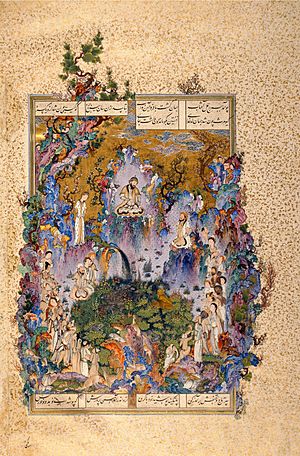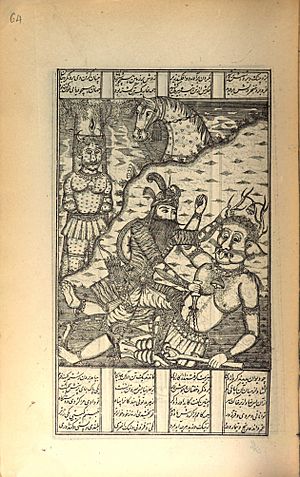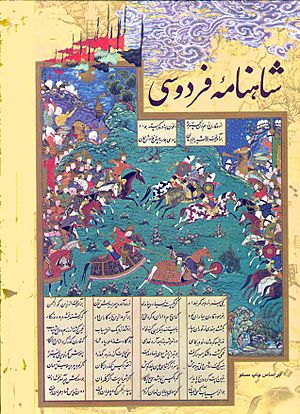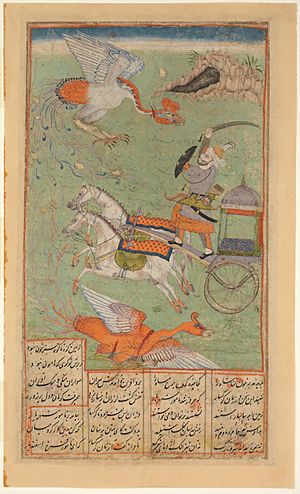Shahnameh facts for kids
| The Book of Kings | |
| by Ferdowsi | |

Court of Keyumars, Miniature by Sultan Muhammad from the Shahnameh of Shah Tahmasp . Aga Khan Museum
|
|
| Original title | شاهنامه |
|---|---|
| Written | 977–1010 CE |
| Country | Iran |
| Language | Classical Persian |
| Subject(s) | Persian mythology, history of Iran |
| Genre(s) | epic poem |
| Meter | Lines of 22 syllables with two rhyming couplets in the same metre (bahr-i mutaqarib-i mahzuf) |
| Publication date | 1010 |
| Published in English | 1832 |
| Media type | manuscript |
| Lines | c. 50,000 depending on manuscript |
| Preceded by | Khwaday-Namag |
| Read online | "Shahnameh" at Wikisource |

The Shahnameh (Persian: شاهنامه, romanized: Šāhnāme, lit. 'The Book of Kings'), also transliterated Shahnama, is a long epic poem written by the Persian poet Ferdowsi between c. 977 and 1010 CE and is the national epic of Greater Iran. Consisting of some 50,000 "distichs" or couplets (two-line verses), the Shahnameh is one of the world's longest epic poems. It tells mainly the mythical and to some extent the historical past of the Persian Empire from the creation of the world until the Muslim conquest in the seventh century. Iran, Azerbaijan, Afghanistan, Tajikistan and the greater region influenced by Persian culture such as Armenia, Dagestan, Georgia, Turkey, Turkmenistan and Uzbekistan celebrate this national epic.
The work is of central importance in Persian culture and Persian language, regarded as a literary masterpiece, and definitive of the ethno-national cultural identity of Iran.
Contents
Illustrated copies

Illustrated copies of the work are among the most sumptuous examples of Persian miniature painting. Several copies remain intact, although two of the most famous, the Houghton Shahnameh and the Great Mongol Shahnameh, were broken up for sheets to be sold separately in the 20th century. A single sheet from the former was sold for £904,000 in 2006. The Baysonghori Shahnameh, an illuminated manuscript copy of the work (Golestan Palace, Iran), is included in UNESCO's Memory of the World Register of cultural heritage items.
The Mongol rulers in Iran revived and spurred the patronage of the Shahnameh in its manuscript form. The "Great Mongol" or Demotte Shahnameh, produced during the reign of the Ilkhanid Sultan Abu Sa'id, is one of the most illustrative and important copies of the Shahnameh.
The Timurids continued the tradition of manuscript production.
The production of illustrated Shahnameh manuscripts in the 15th century remained vigorous during the Qarā-Qoyunlu or Black Sheep (1380–1468) and Āq Qoyunlu or White Sheep (1378–1508) Turkman dynasties. Many of the extant illustrated copies, with more than seventy or more paintings, are attributable to Tabriz, Shiraz, and Baghdad beginning in about the 1450s–60s and continuing to the end of the century.
The Safavid era saw a resurgence of Shahnameh productions. Shah Ismail I used the epic for propaganda purposes: as a gesture of Persian patriotism, as a celebration of renewed Persian rule, and as a reassertion of Persian royal authority. The Safavids commissioned elaborate copies of the Shahnameh to support their legitimacy. Among the high points of Shahnameh illustrations was the series of 250 miniatures commissioned by Shah Ismail for his son's Shahnameh of Shah Tahmasp. Two similar cycles of illustration of the mid-17th century, the Shahnameh of Rashida and the Windsor Shahnameh, come from the last great period of the Persian miniature.
In honour of the Shahnameh's millennial anniversary, in 2010 the Fitzwilliam Museum in Cambridge hosted a major exhibition, called "Epic of the Persian Kings: The Art of Ferdowsi’s Shahnameh", which ran from September 2010 to January 2011. The Arthur M. Sackler Gallery of the Smithsonian Institution in Washington, DC also hosted an exhibition of folios from the 14th through the 16th centuries, called "Shahnama: 1000 Years of the Persian Book of Kings", from October 2010 to April 2011.
In 2013 Hamid Rahmanian illustrated a new English translation of the Shahnameh (translated by Ahmad Sadri) creating new imagery from old manuscripts.
Modern editions


English translations
There have been a number of English translations, almost all abridged. James Atkinson of the East India Company's medical service undertook a translation into English in his 1832 publication for the Oriental Translation Fund of Great Britain and Ireland, now part of the Royal Asiatic Society. Between 1905 and 1925, the brothers Arthur and Edmond Warner published a translation of the complete work in nine volumes, now out of print. There are also modern incomplete translations of the Shahnameh: Reuben Levy's 1967 prose version (later revised by Amin Banani), and another by Dick Davis in a mixture of poetry and prose which appeared in 2006. Also a new English translation of the book in prose by Ahmad Sadri was published in 2013.
The Parsis, Zoroastrians, whose ancestors had migrated to India in the 8th or 10th century so they could continue practice of their religion in peace, have also kept the Shahnameh traditions alive. Dr. Bahman Sohrabji Surti, assisted by Marzban Giara, published between 1986 and 1988 the first detailed and complete translation of the Shahnameh from the original Persian verse into English prose, in seven volumes.
Other languages
There are various translations in French and German. An Italian translation was published in eight volumes by Italo Pizzi with the title Il libro dei re. Poema epico recato dal persiano in versi italiani da Italo Pizzi, 8 voll., Torino, Vincenzo Bona, 1886–1888 (later reissued in two volumes with a compendium, from UTET, Turin, 1915).
Dastur Faramroz Kutar and his brother Ervad Mahiyar Kutar translated the Shahnameh into Gujarati verse and prose and published 10 volumes between 1914 and 1918.
A Spanish translation was published in two volumes by the Islamic Research Institute of the Tehran Branch of McGill University.
See also
 In Spanish: Shāhnāmé para niños
In Spanish: Shāhnāmé para niños
- List of Shahnameh characters
- List of places in Shahnameh
- List of women in Shahnameh
- Rostam and Esfandiyar
- Rostam's Seven Labours
- Zal and Rudaba
- Naqqāli, a performing art based on Shahnameh
- Rostam and Sohrab, an opera by Loris Tjeknavorian
- Sohrab and Rustum, an 1853 poem by Matthew Arnold
- Vis and Rāmin, an epic poem similar to the Shahnameh
- Mir Jalaleddin Kazzazi
- Shahrokh Meskoob
Images for kids
-
Georgian manuscript of Shahnameh written in the Georgian script.
-
An image illustrating the parable of the ship of faith from the Houghton Shahnameh (Metropolitan Museum of Art)














